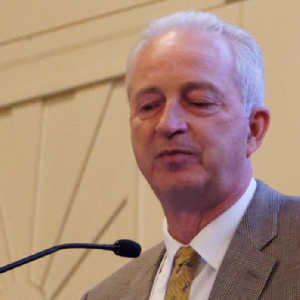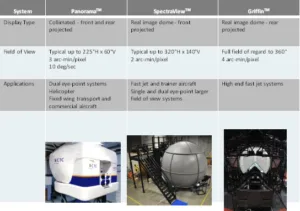
Dave Eccles is from Rockwell Collins (RC) and he said he has a great job – he gets paid to play games. Simulators are now so good that simulation counts as flight time, so you can qualify as a commercial pilot without ever flying a real plane. He explained that some simulators often need collimated displays, which means that the focus is at infinity. Rockwell Collins has a range of simulators.
One of the simulators is the RC Griffin dome which is painted by robots on the inside and has 25 projectors that have to be seamlessly blended. Usually, with just a few projectors to be blended you can use optical filters, but with 25 it’s very difficult, because you get multiple overlaps. LCOS is not as ‘deterministic’ as DLP, so you have to tune them. RC designed their own system to correct the projectors using cameras.
Some time ago, SID Fellow, Pete Barten, said that MTF should be used (MTFA) to measure resolution. There are lots of ways to measure, but you can look at displays and see issues that are hard to measure. Eccles supports the IDMS and one of the requirements for simulation projection systems is “No disturbing visual artefacts”. The RC method of checking this is to get a pilot in to see potential displays and hope that they don’t say ‘I don’t like that’. There is a policy of ‘no negative training’ which should be as realistic as possible.
RC made the first 4 LCOS projector – the fourth one modulates the light to multiply contrast, which is good but it means that the projector loses half of its brightness. The first ProSum was just 1100 lumens and lamp-based with a 1500 hours lamp replacement cycle, but producing 1 million to 1 contrast. You need more contrast than you can see in simulators and you also need to be able to have good contrast with night vision goggles. The projector has 13ms latency maximum and black has to go ‘below black’. It seems that most fighter jets are flown at night so performance with night vision goggles are important.
In flight simulators, nobody cares about saturation, Eccles said, because of that haze that is normal when flying. You need HDR to show landing lights as really glaring at night and cause blooming in the goggles, which you need to simulate. Pilots typically don’t care about colour, but you need red, orange, yellow and green. Pilots have incredible vision – 20:5 vision. He once asked a pilot if he needed high resolution to see enemy aircraft, but was told “I can see the other guy, it’s too late”. Response times are important.
Rockwell bought the Matrix projector line from Christie in Feb 2016 (Rockwell Collins Buys Simulation Projector Line from Christie). Would we like more lumens (they have 600 or 800 lumens)? Sure, said Eccles.
In commercial flight simulators, JVC projectors are often used by RC. Specs have recently got tougher for simulation and latency needs to be 100ms or less for helicopters, but 150ms is OK for other planes. Enhancements to commercial simulators are often not mandated because of potential problems with redundancy. In other words, if the requirements change because of a regulation, there may be no simulators that are then able to be used for pilot qualification.
RC’s simulators have image generators (IGs) that use Nvidia cards, but RC has 3D processing expertise as it bought Evans & Sutherland years ago. At Sony, there were some tests done to understand image blurring and Eccles said that at 450Hz, you can’t see blur at all, but 120Hz is a big improvement over 60Hz. However, there is a trade off with textures and GPU processing, customers prefer better textures and that takes more processing time, making high frame rates difficult. You can’t do warping and blending in the projector because of latency as you only have 13ms in the projector itself, so it’s better to do those processes in the GPU.
RC has a real world database (which we reported on at I/Itsec (How Rockwell Collins WholeEarth Database can Save Money) and the whole database is less than 2TB.
In response to a question, an audience member mentioned that colour would be important in maritime simulation and ‘call to fire’ simulators. The sea colours are important.

